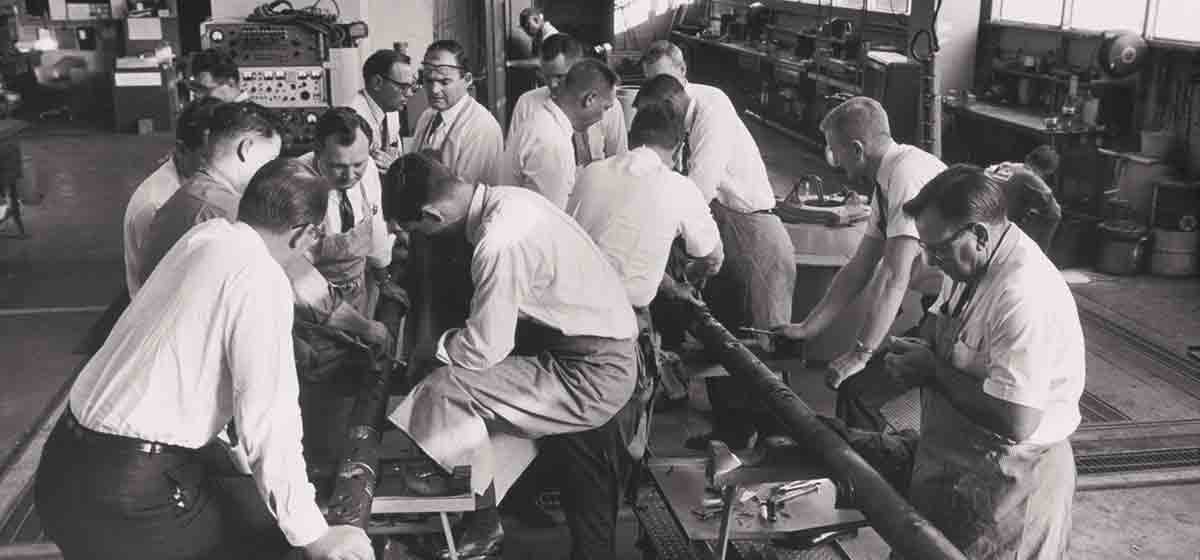1950s
New technology, strategic acquisitions

Electronics had emerged as an area for scientific study in the 1930s, but its promise as a powerful and commercially viable ingredient in data recording and transmission was only just starting to be realized. Schlumberger was now incorporating electronics into several of its new tools, enabling the company to provide smaller, more robust equipment.
Development efforts were now focused on two types of sophisticated electronic sondes, or probes. The first type was capable of taking high-resolution measurements close to the borehole wall and in very thin beds—tools such as the microlog and the microlaterolog. The microlog, introduced in 1948, was a high-resolution array of three electrodes and an insulating pad that could detect permeable zones across which mudcake had formed when it was applied to a borehole wall. The microlaterolog investigated deeper and delivered data on the resistivity of the flushed zone—the rock around the borehole flushed with drilling fluids.
The second type, the induction log, took measurements farther from the borehole in areas of the formation unaffected by the presence of the well, making it suitable for wells drilled with oil-based fluids. The first induction log was recorded in Texas in 1946. The first commercial induction tool was introduced in the Gulf of Mexico in 1952, and the first induction-electrical log was brought onto the market four years after that. In 1959, Schlumberger introduced what became the industry-standard induction array. These new tools provided accurate data that could be computer processed to give a quantitative interpretation of the potential oil production of the reservoir rock.
In 1951, Schlumberger began to experiment with a microneutron device, which could measure formation porosity by sensing the amount of hydrogen present. Work also got under way on another technique for quantifying formation porosity based on attenuation of gamma rays. Sonic measurements, introduced in 1952, provided better depth control for perforations and for placing well completion equipment; their use quickly spread into other areas, such as rock property evaluation, porosity and fracture analysis, cement evaluation, and the correlation of well logs and seismic data.
The technology later incorporated into the Schlumberger accelerator porosity tool (APT) had its origins around this time, with work that began in 1955 on "slowing down time," a technique to measure formation hydrogen concentration by detecting energy reduction of source neutrons. The precursors to today's modular fluid sampling and pressure testing tools also emerged, when, in 1956, Henri Doll patented methods of determining hydraulic characteristics of formations traversed by a borehole.
Schlumberger also strengthened its operations through restructuring and strategic acquisitions. Schlumberger Limited was created as a holding company registered in Curaçao in 1956. Henri Doll was appointed as its first Chairman of the Board of Schlumberger Limited, and, three years after Marcel Schlumberger died, his son Pierre Schlumberger became President. The company bought 50% of each of the French drilling rig companies Forage et Exploitations Pétrolières (Forex) and Société Languedocienne de Forages Pétroliers (Languedocienne) in 1952 and, four years later, it acquired Johnston Testers, the first of many acquisitions enabling Schlumberger to supply a more complete spectrum of formation evaluation measurements.
Alert to the potential stresses placed on the company's knowledge base by its rapid expansion, in 1956 Schlumberger initiated the practice of assigning senior technical staff to support young field engineers—a move that has served the company well ever since. Roger Jost, one of the trio that ran the first log at Pechelbronn in 1927, was assigned to the Paris office, where he answered questions and tested equipment before it was deployed. Today, all SLB engineers benefit from a centralized system connecting them to people and information, so lessons learned in one place are learned by all. In 1959, Schlumberger established its first engineering center in Clamart, France.
| Year | Event |
|---|---|
| Year 1950 | Event Introduces laterolog tool for focusing currents into thin rock layers beyond the borehole Launches The Technical Review (the forerunner of the Oilfield Review, discontinued in 2016) |
| Year 1951 | Event Introduces microlaterolog tool for measuring resistivity near the borehole Begins experiments with microneutron device to measure formation porosity by sensing the amount of hydrogen present Starts work on attenuation of gamma rays, leading to a technique for quantifying formation porosity Undertakes research on density logging |
| Year 1952 | Event Buys 50% of Forex and Languedocienne drilling rig companies Gathers first computer-ready data in the field Introduces sonic measurements for better depth control for perforations and placing well completion equipment |
| Year 1953 | Event Marcel Schlumberger dies |
| Year 1954 | Event Introduces microlog for recording borehole diameter First well log in Australia is performed |
| Year 1955 | Event Begins work on "slowing down time" technique to measure formation hydrogen concentration by detecting energy reduction of source neutrons |
| Year 1956 | Event Acquires Johnston Testers, a US testing and production company Completes first induction-electrical log Forms Schlumberger Limited in Curaçao as holding company for all Schlumberger businesses Patents method for determining hydraulic characteristics of a formation traversed by a borehole |
| Year 1957 | Event Completes first density log, enabling realization of bulk density measurement using gamma ray attenuation Acquires Electro-Mechanical Research (EMR) that included three divisions: Princeton Division (ASCOP), Sarasota Products Division, and Systems Division |
| Year 1959 | Event Develops prototype of compensated formation density (CFD) tool in Ridgefield Founds engineering center in Clamart, France |
